Within


Badge Jason Landers Northam
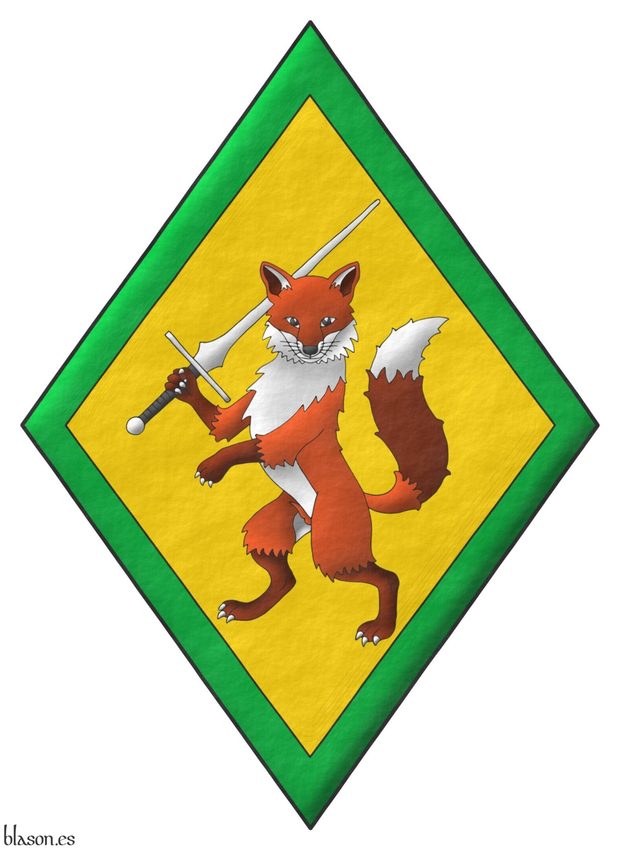
A lozenge Or, charged with a fox rampant, guardant, holding in its dexter paw a federschwert bend sinisterwise proper, within a bordure Vert.
Heraldic device painted by me, illuminated with lights and shadows, outlined in Sable, and with a rough finish.
Heraldic badge of Jason Landers Northam from Illinois, emblazoned by me. The federschwert, feder sword, or «feather sword» translated from German, is a training sword developed in the late 15th century and used during the 16th century in Renaissance fencing schools. Its design allowed safe and realistic practice, reducing the risk of serious injuries while preserving the handling of a real sword. Today it remains in use within Historical European Martial Arts, combining historical fidelity with safety.
Blazon keywords: Or, Vert, One, Lozenge, Fox, Rampant, Guardant, Federschwert, Sword, Proper, Within and Bordure.
Style keywords: Outlined in sable, Illuminated and Rough.
Classification: Personal, Interpreted, Boa and Badge.
Bearer: Northam, Jason Landers.


Jesus Christ, with bezants Or

Azure, a pall couped Argent, its three arms charged with «es» Sable, within a triangle reversed Argent, its three arms charged with «no es» Sable, all debruised by four bezants, three on the vertex of the triangle, in dexter chief, charged with «el Padre», in sinister chief, charged with «el Hijo», in base, charged with «el Espítiru», and one on the fess point, charged with «Dios» Gules; in chief a label of three points Argent.
Escudo de azur, una perla recortada de plata, sus tres brazos cargados con «es» de sable, dentro de un triángulo ranversado de plata, sus tres brazos cargados con «no es» de sable, todo resaltado de cuatro bezantes de oro, tres sobre los vértices del triángulo, en la diestra del jefe, cargado de «el Padre», en la siniestra del jefe, cargado con «el Hijo», en la punta, cargado con «el Espítiru» y uno sobre el corazón, cargado con «Dios» todo de gules; en jefe un lambel de tres pendientes de plata.
Imaginary coat of arms that I have interpreted as follows: its base is semicircular (round); its field is illuminated in Azure; the rest is illuminated in Argent and outlined in Sable, except for the bezants which are Or and also outlined in Sable; its letters in plain tinctures, some Gules and others Sable; and the set with a glazed finish.
Pall
The pall (perla) as defined by [Avilés, J.; 1780a; page 239] is «a figure composed of three moving cotises, or that emerge from the two angles of the Chief and the Base, which meet in the center or heart of the Shield in the form of a Greek Y, as if this figure were formed from a half Saltire, and a half Pale».
Blazon keywords: Without divisions, Azure, One, Pall, Couped, Argent, Three, Charged, Letter, Sable, Within, Triangle, Reversed, Four, Bezant, In the dexter chief, In the sinister chief, In base, In the fess point, Gules, Cadency and Label of three points.
Style keywords: Semi-circular, Illuminated, Outlined in sable and Glass.
Classification: Religious, Interpreted, Imaginary and Coat of arms.
Imaginary bearer: Jesus Christ.


Motto around the shield of Alejandra Espeja Avieda

Or, four bell towers issuant from base Gules, windows Or. Motto around the shield: «Linaje Lanzagorta Otxoa · Catalunya · Barcelona» Sable over a scroll Argent.
Coat of arms painted by me, in plain tinctures, contoured in Sable, with a semi-circular external shape and with a texturized finishing.
Coat of arms of Alejandra Espeja Avieda, familiarly known as Sandra. This shield, surrounded by an annular scroll Argent inscribed in sable, has been designed byhas been designed by Juan Lanzagorta Vallín and emblazoned by me.
Blazon keywords: Or, Gules, Sable, Argent, Four, One, Bell tower, Issuant from base, Port and windows, Within, Motto (identification) and Scroll.
Style keywords: Outlined in sable, Plain tincture and Semi-circular.
Classification: Personal, Interpreted, Boa and Coat of arms.
Bearer: Espeja Avieda, Alejandra.


Motto around the shield of Juan Lanzagorta Vallín
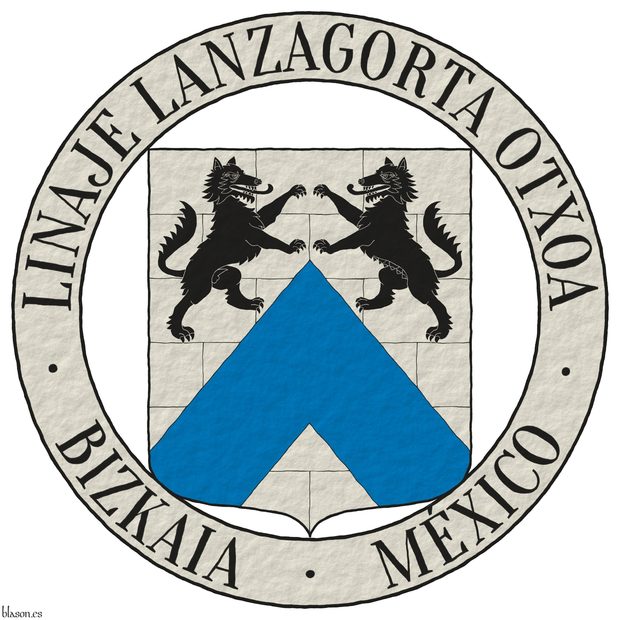
Argent masoned Sable, a chevron Azure, in chief a wolf and a she-wolf combatant Sable. Motto around the shield: «Linaje Lanzagorta Otxoa · Bizkaia · México» Sable over a scroll Argent.
Arms interpreted by me, in flat tinctures, contoured in Sable, with an ogee external shape and with a texturized finishing.
Coat of arms of Juan Lanzagorta Vallin designed by him and emblazoned by me. I have never painted a field masoned sable.
Credits: Juan Lanzagorta Vallin is the designer of the coat of arms.
Blazon keywords: Azure, Argent, Sable, One, Two, Masoned, Chevron, In chief, Wolf, She-wolf, Combatant, Within, Motto (identification) and Scroll.
Style keywords: Outlined in sable, Plain tincture and Ogee.
Classification: Personal, Interpreted, Boa and Coat of arms.
Bearer: Lanzagorta Vallín, Juan.


Motto around the shield of Teresa Otxoa Magaña
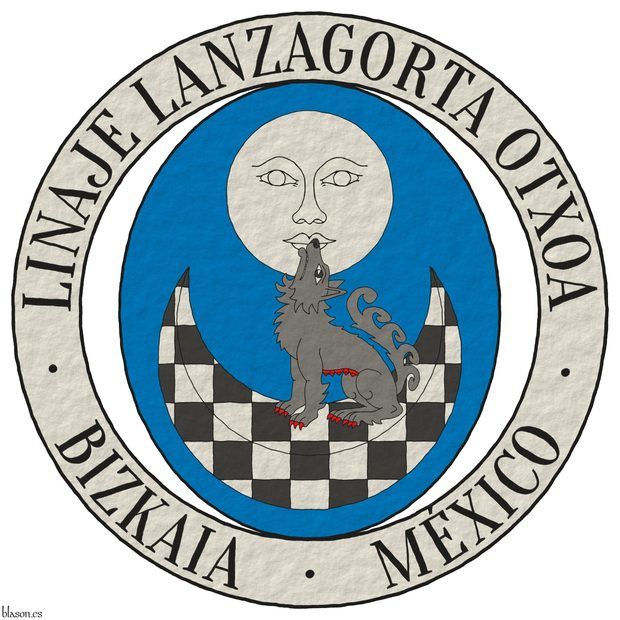
Azure, in chief a moon with human face Argent, in base a crescent chequey Sable and Argent; overall a she-wolf ululant, sejant on the crescent proper, armed and the udders Gules. Motto around the shield: «Linaje Lanzagorta Otxoa · Bizkaia · México» Sable over a scroll Argent.
Arms depicted by me, in plain tinctures, outlined in Sable, with an oval outer contour and with a texturized finish.
The coat of arms of Teresa Otxoa Magaña designed by her and her husband Juan Lanzagorta Vallín, and emblazoned by me.
Blazon keywords: Azure, Argent, Sable, Gules, One, Chief, Moon, With human face, Base, Crescent, Chequey, Overall, She-wolf, Ululant, Sejant, Proper, Armed, Udder, Within, Motto (identification) and Scroll.
Style keywords: Outlined in sable, Plain tincture and Oval.
Classification: Personal, Interpreted, Boa and Coat of arms.
Bearer: Otxoa Magaña, Teresa.


Royal Spanish Academy, emblem
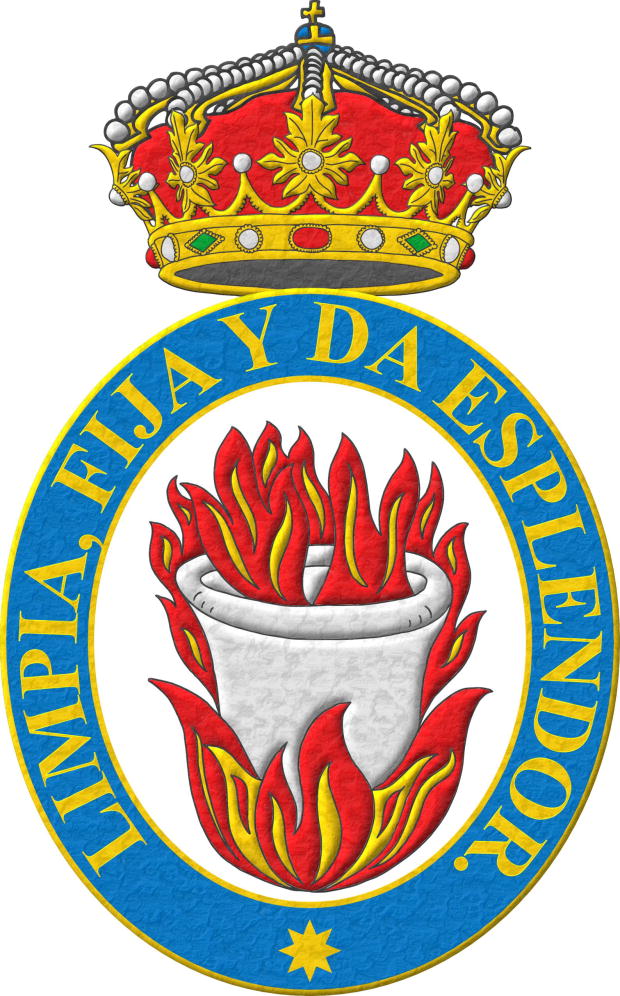
Emblemb Argent, a crucible Argent, enflamed and on a bonfire hoguera Gules and Or. Crest: A closed royal crown Or, with eight arches, visible five. Motto around the shield: «Limpia, fixa, y da esplendor» Or over a scroll Azure, fimbriated Or.
Emblema de plata, un crisol de plata, llameante y sumado a una hoguera de gules y oro. Timbrado de una corona real cerrada. Lema alrededor del escudo: «Limpia, fixa, y da esplendor» de oro sobre una filacteria de azur, perfilada de oro.
Painted by me with a metalwork finish, with an oval shape.
The Royal Spanish Academy was founded in 1713 on the initiative of Juan Manuel Fernández Pacheco, eighth Marquess of Villena and Duke of Escalona, with the aim of «fixing the words and vocabulary of the Castilian language in its greatest propriety, elegance, and purity». A year later, in 1714, its creation was approved by a Royal Decree of Philip V.
To symbolize its purpose, its emblem with a crucible to the fire and its motto «Limpia, fija y da esplendor» [Zamora Vicente, A.; 1999] were chosen by secret ballot. In some old versions of this emblem the motto can be read with the term «fixa» and a comma before the conjunction, that is, «Limpia, fixa, y da esplendor».
This article is illustrated with my personal interpretation of this emblem of the Royal Spanish Academy, crested with a closed royal crown of 8 arches, of which the 5 frontal ones are completely visible.
In this, as in any of my works, I always consult its dictionaries, almost as much, as the most interesting and specific works on the subject of study.
Blazon keywords: Without divisions, Argent, One, Crucible, Enflamed, Bonfire, Gules, Or, Closed royal crown, Crown, Motto, Within, Scroll, Azure and Fimbriated.
Style keywords: Oval, Illuminated and Outlined in sable.
Classification: Interpreted, Socioeconomic, Metalwork and Emblem.
Bearer: Royal Spanish Academy.


![Ver [Royal Spanish Academy; 2001] en referencias bibliográficas. Libro abierto, hojas de plata, filo de oro, guardas de gules, tapas de sable.](../css/Libro.Bibliografia.png)
Royal Spanish Academy; 2001
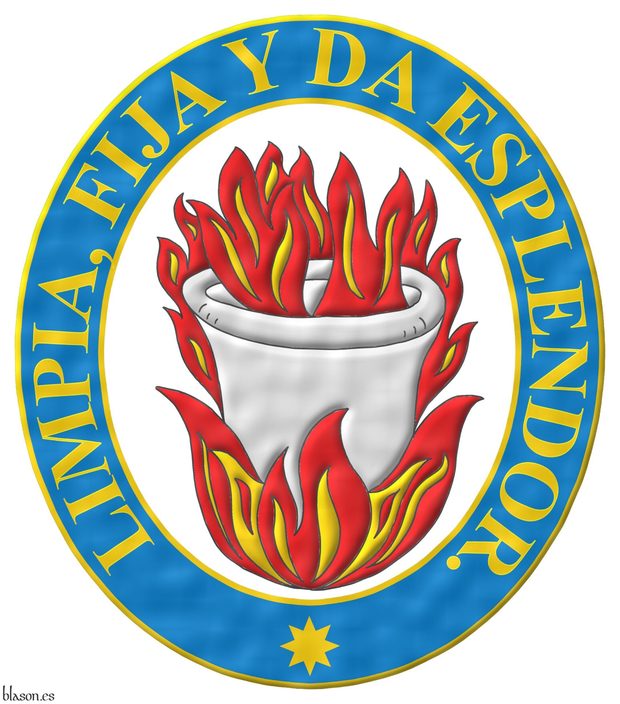
Real Academia Española, «Diccionario de la lengua española», known as DRAE, acronym for Diccionario de la Real Academia Española, 22nd edition, Espasa Calpe, Madrid, 2001.
The DRAE's latest edition, the 23rd, is from October 2014, but the current online version corresponds to the 22nd edition with amendments incorporated until 2012.
This bibliographic reference is illustrated with one of my interpretations of the emblem of the Real Academia Española, with its crucible over a bonfire and its motto around it.
Bibliographical reference of century XXI.
Classification: Dictionary and Castilian language.
Author: Royal Spanish Academy.
The following article cites this bibliographic reference:
External resource:


![Ver [Royal Spanish Academy; 2014] en referencias bibliográficas. Libro abierto, hojas de plata, filo de oro, guardas de gules, tapas de sable.](../css/Libro.Bibliografia.png)
Royal Spanish Academy; 2014

Real Academia Española, «Diccionario de la lengua española», known as DRAE, acronym for Diccionario de la Real Academia Española, 23rd edition, Espasa Calpe, Madrid, 2014.
This bibliographic reference of the DRAE is illustrated with one of my interpretations of the emblem of the Real Academia Española. Oval emblem with its crucible over a bonfire, surmounted by a closed Royal crown and its motto «Limpia, fija y da esplendor», around the emblem in letters of Or on Azure.
Bibliographical reference of century XXI.
Classification: Dictionary and Castilian language.
Author: Royal Spanish Academy.
The following article cites this bibliographic reference:
External link:


Talbot, lineage of England

Blazon of the Talbot lineage of England.
Escudo de gules, un león rampante dentro de una bordura angrelada todo oro.
Gules, a lion rampant within a bordure engrailed Or.
Illuminated with lights and shadows and with a freehand finish.
[Rietstap, J. B.; 1861] writes it in French as «de gueules, au lion d'or, à la bordure engrelée du même». y [Burke, J.; 1836; volume 3, pages 359-360] writes it in English as «Gu. a lion rampant, within a bordure engr. or».
Blazon keywords: Without divisions, Gules, One, Lion, Rampant, Within, Bordure, Engrailed and Or.
Style keywords: Freehand, Outlined in sable, Illuminated and Semi-circular.
Classification: Interpreted, Lineage and Kingdom of England.


The Heraldry Society, motto

Quarterly Azure and Gules; overall a leopard face, crowned Or, langued Gules, within a tressure flory Or. Motto: «Entalente a parler d'armes».
Escudo cuartelado de azur y gules; brochante sobre el todo, una cabeza de leopardo coronada de oro, lampasada de gules, dentro de un trechor flordelisado de oro. Lema: «Entalente a parler d'armes».
The official blazon of this coat of arms is «Quarterly Azure and Gules a lion’s face crowned with an Ancient Crown Or within a tressure flory on the outer edge of the same». The following are my comments to the official blazon:
- With «crowned» can be assumed the common default «crowned with an ancient crown».
- With «tressure flory» can be assumed the common default «tressure flory on the outer edge».
- I use to specify the «langued», for example Gules or Azure, because I think there is not a common default tincture for «langued» in all heraldic traditions.
- The use of «overall» can help to understand the blazon, then I add it.
Blazon keywords: Quarterly, Azure, Gules, Overall, Head, Leopard, Crowned, Or, Langued, Within, Tressure, Flory and Motto.
Style keywords: Pointed, Illuminated, Outlined in sable, Shaded and Freehand.
Classification: Interpreted, Socioeconomic and Coat of arms.
Bearer: The Heraldry Society.


![Ver [Zamora Vicente, A.; 1999] en referencias bibliográficas. Libro abierto, hojas de plata, filo de oro, guardas de gules, tapas de sable.](../css/Libro.Bibliografia.png)
Zamora Vicente, A.; 1999
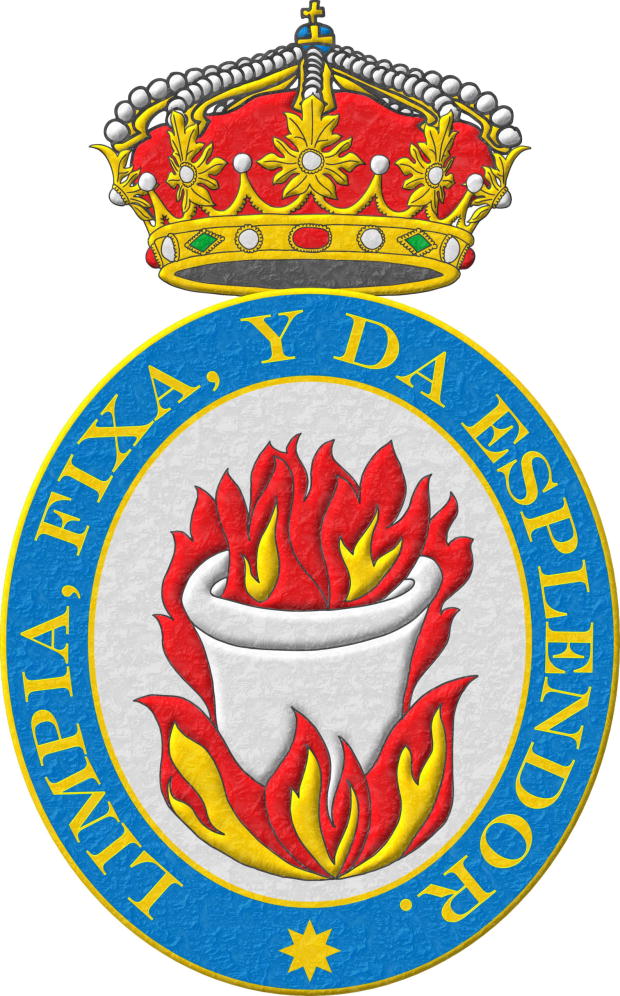
Alonso Zamora Vicente, «Historia de la Real Academia Española», Real Academia Española, Espasa Calpe, Madrid, 1999.
This bibliographic reference is illustrated with one of my interpretations of the emblem of the Real Academia Española. It is an oval emblem in Argent, with its crucible, also in Argent, over a bonfire of Gules and Or and surrounded by its flames, surmounted by a closed Royal crown with 8 arches, 5 of which are visible, and its motto, as originally written «Limpia, fixa, y da esplendor», around it.
Bibliographical reference of century XX.
Classification: Castilian language.
The author is Zamora Vicente, Alonso.
Bibliographical reference mentioned in the following article:
External resource:
-
Language
-
Categories of heraldry
-
Divisions of the field
- Without divisions
- Party per pale
- Party per fess
- Party per bend
- Party per bend sinister
- Tierce
- Tierce sinister
- Tierced per pale
- Tierced per fess
- Tierced per bend
- Tierced pallwise inverted
- Quarterly
- Quarterly per saltire
- Gyronny
- Party per fess, the chief per pale
- Party per pale, the sinister per fess
- Party per fess, the base per pale
- Party per pale, the dexter per fess
- Chapé
- Chaussé
- Embrassé
- Contre-embrassé
- Party per chevron
- Enté
- Enté en point
- Flanched
-
Metals
-
Colours
-
Furs
-
Other tinctures
-
Ordinaries and sub-ordinaries
-
Diminutives of the ordinaries
-
Geometric charges
-
Composite ordinaries
-
Inanimate charges from Nature
Atom, Crescent, Diamond, Emerald, Estoile, Increscent, Lightning flash, Moon, Mount, Mullet, Mullet of four points, Orbital, Plough of Ursa Major, Rainbow, Ray of the sun, River, Sea, Snowflake, Sun, Sun in splendour, Sun of May, Trimount and Water.
-
Vegetal charges from Nature
Acorn, Apple, Apple tree, Ash, Bluebonnet, Camellia, Chrysanthemum, Cinquefoil, Cornflower, Dogwood flower, Double rose, Elm, Fleur de lis, Flower, Gourd, Holm oak, Hop cone, Kapok tree, Laurel, Lily, Linden, Lotus flower, Madonna lily, Oak, Olive tree, Palm tree, Pomegranate, Poplar leaf, Rose, Shamrock, Sunflower, Thistle, Tree, Tulip, Vine and Wheat.
-
Animal charges from Nature
Badger, Bald eagle, Barbel, Barn owl, Bear, Beaver, Beetle, Bighorn sheep, Blackbird, Boar, Brach hound, Bull, Doe, Dog, Dolphin, Dove, Eagle, Elephant, Falcon, Fish, Flame, Fly, Fox, Frog, Goat, Goldfinch, Goose, Heron, Horse, Hummingbird, Jaguar, Lark, Leopard, Lion, Lion passant, Lion rampant guardant, Lioness, Lynx, Male figure, Martlet, Merino ram, Owl, Panther, Parrot, Peacock, Pelican, Pelican in her piety, Puffin, Quetzal, Raven, Roe deer, Rooster, Savage, Seagull, Serpent, She-wolf, Stag, Starling, Talbot, Tyger, Vulture, Warren hound and Wolf.
-
Parts of natural charges
Arm, Beak, Branch, Caboshed, Chest, Claw, Covert, Dorsal fin, Eagle claw, Ermine spot, Escallop, Feather, Foot (palmiped), Foreleg, Forepaw, Hand, Head, Heart, Hoof, Leaf, Neck, Ostrich feather, Palm frond, Paw, Roe deers' attires, Shoulder, Sprig, Stags' attires, Stem, Swallow-tail, Tail, Tail addorsed, Tail fin, Talon, Tooth, Trunk, Trunk (elephant), Two hands clasped, Two wings in vol, Udder, Wheat spike, Wing and Wrist.
-
Artificial charges
Ace of spades, Anchor, Anvil, Arch, Arm vambraced, Armillary sphere, Arrow, Axe, Bell, Bell tower, Beret, Bonfire, Book, Bookmark, Bow, Bridge, Broken, Buckle, Cannon, Cannon dismounted, Cannon port, Canopy roof, Carbuncle, Castle, Celtic Trinity knot, Chain, Chess rooks, Church, Clarion, Clay pot, Closed book, Club, Comb, Compass rose, Conductor's baton, Cord, Covered cup, Crozier, Crucible, Cuffed, Cup, Cyclamor, Dagger, Double vajra, Drum, Ecclesiastical cap, Fanon, Federschwert, Fleam, Four crescents joined millsailwise, Galician granary, Garb, Gauntlet, Geometric solid, Grenade, Halberd, Hammer, Harp, Host, Hourglass, Key, Key ward, Knight, Knot, Lantern, Letter, Line, Loincloth, Menorah, Millrind, Millstone, Millwheel, Monstrance, Mortar, Mullet of six points pierced, Nail, Non-classic artifact, Norman ship, Number, Oar, Oil lamp, Open book, Page, Pair of scales, Parchment, Pestle, Piano, Pilgrim's staff, Plough share, Polish winged hussar, Port, Portcullis, Potent, Quill, Ribbon, Rosette of acanthus leaves, Sabre, Sackbut, Sail, Scroll, Scythe, Sheaf of tobacco, Ship, Skirt, Spear, Spear's head, Stairway, Star of David, Step, Sword, Symbol, Tetrahedron, Torch, Tower, Trident, Trumpet, Turret, Two-handed sword, Wagon-wheel, Water-bouget, Wheel, Winnowing fan and With a turret.
-
Immaterial charges
Angel, Archangel, Basilisk, Dragon, Dragon's head, Garuda, Golden fleece, Griffin, Heart enflamed, Mermaid, Our Lady of Mercy, Ouroboros, Paschal lamb, Pegasus, Phoenix, Sacred Heart of Jesus, Saint George, Sea-griffin, Trinity, Triton, Unicorn, Winged hand and Wyvern.
-
External elements
-
Heraldic creations
-
References
-
Formats
-
Keywords on this page
Port and windows, Combatant, Chequey, Proper, Engrailed, Pointed, Armed, Ululant, Azure, Bezant, Bibliography, Boa, Bordure, Cadency, Overall, Head, Crown, Closed royal crown, Crucible, Four, Outlined in sable, Within, Dictionary, Motto (identification), Emblem, Coat of arms, Scroll, Personal, Gules, Bonfire, Illuminated, Interpreted, Motto, Castilian language, Enflamed, She-wolf, Semi-circular, Or, Oval, Fimbriated, Argent, Without divisions, Rampant, Sable, Century XXI, Socioeconomic, Plain tincture, Freehand and One.
